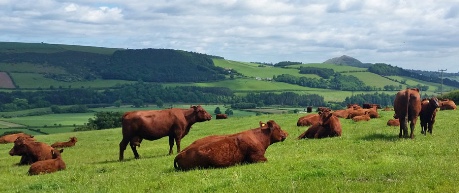Friday 4th October 2019, 3:00pm
A toxin produced by E. coli bacteria is responsible for the emergence of a life-threatening disease in people.

The toxin – produced by naturally occurring E. coli – helps these bacteria colonise the intestinal tract of cattle and increases transmission of the bacteria to other animals in the herd, scientists found.
Rapid and high levels of expression of the toxin also means that when humans are infected, they are more likely to suffer more serious symptoms.This helps explain the emergence of this dangerous human pathogen over the past 40 years.
Enterohaemorrhagic E. coli (EHEC) O157 are a subset of E. coli that are present in the gastrointestinal tract of cattle but cause no discernible disease in these animals. However, EHEC O157 excreted in the faeces of infected cattle can be passed on to people through exposure to contaminated water, meat or vegetables, causing disease.EHEC produce toxins known as Shiga toxins, of various sub-types.
These toxins cause from diarrhoea to more severe and potentially fatal kidney disease in people, by attacking the lining of blood vessels within the body.The study, involving a collaboration between scientists at Moredun Research Institute, The Roslin Institute, Biomathematics and Statistics Scotland and international partners, investigated the role in colonisation of the cattle gut of the most dangerous toxin subtype to humans – called Stx2a.
"Most human infections are thought to originate from cattle and infections with E. coli O157 strains containing Stx2a are associated with more severe forms of human disease. Our study shows for the first time that Stx2a toxin plays a key role in allowing E. coli O157 to colonise the cattle gut, increasing the ability of Stx2a positive bacteria to transmit between animals and shed at high levels into the environment."
Dr Tom McNeilly, Moredun Research InstituteThis essentially allows infected cells to survive for longer, making it more likely that the cattle will shed the bacteria in their faeces for longer and at higher levels, thus increasing the chance of transmission to others.
"The study is important as it explains firstly why the Stx2a subtype has become common in E. coli O157 strains, the answer being that it can be produced more rapidly compared to some other Stx subtypes.
Secondly, our work demonstrates how the toxin can provide an advantage in the animal host, basically by halting the usual turnover of gut cells that would remove E. coli; so the bacteria colonise more easily, persist in the gut and can be excreted at high levels to go onto infect other animals and possibly humans."
Professor David Gally, The Roslin InstituteOngoing work between these partners has developed a vaccine for use in cattle that has recently obtained commercial backing for a field trial.
The study was funded by the Food Standards Agency/Food Standards Scotland.
Source: The Roslin Institute